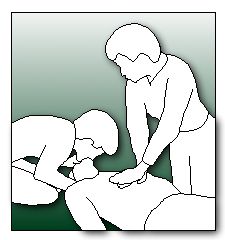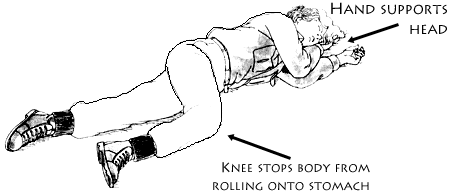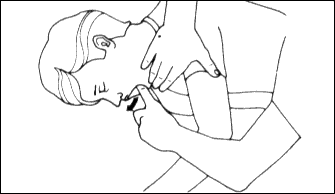
Stay Alive
An Independent ThinkQuest Student Project
 | Equipped To Survive™ Presents Stay Alive An Independent ThinkQuest Student Project |

1. To check an unconscious victim, place two fingers under his chin and a hand on his forehead. Tilt his head back to open his airway. Remove any obstructions from his mouth.2. Listen and feel for victim's breathing. If he is breathing, place him in the recovery position. If he is not breathing, begin rescue breathing.
3. Check the victim's circulation by feeling for a pulse at the side of his windpipe (carotid artery). If there is no pulse, begin CPR immediately.

1. If a victim is unconscious but breathing, bend his near arm up at a right angle to his body. Hold the back of his far hand to his near cheek. With the near leg straight, pull the far knee toward you.2. With the victim on his side, place his uppermost leg at a right angles to his body. His head will be supported by the hand of the uppermost arm. Tilt his head back so that he will not choke if he vomits.

1. To ensure an open airway, first clear the victim's mouth of obstructions, then place one hand under his chin and one on his forehead, and tilt his head back.2. Pinching the victim's nose shut, clamp your mouth over his mouth, and blow steadily for about two seconds until his chest rises. Remove your mouth and let his chest fall, then repeat.
3. Listen for the victim's breathing and check his pulse. If he still has a pulse, give 10 breaths per minute until help arrives or the victim is breathing by himself. If the pulse has stopped, combine rescue breathing with chest compressions.
 (also see image above)
(also see image above)If a person's heart has stopped, give cardiopulmonary resuscitation (CPR). This consists of chest compressions to maintain the blood flow to the brain, combined with rescue breathing to oxygenate the blood. Give chest compressions at a rate of 80 per minute, counting "one-and-two-and..."
1. Place the heel of your hand two finger-widths up from the end of the sternum and your other hand on top of the first. Press down firmly, then release.2. Check for a pulse. After 15 chest compressions, give the victim two breaths of rescue breathing. Repeat until the pulse restarts, professional help arrives, or you are too exhausted to continue.